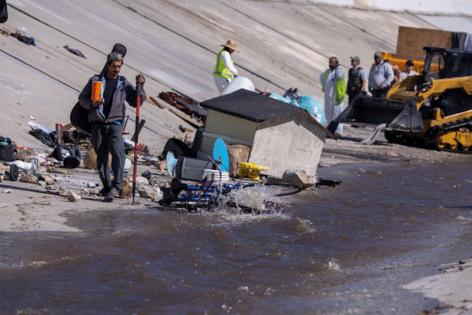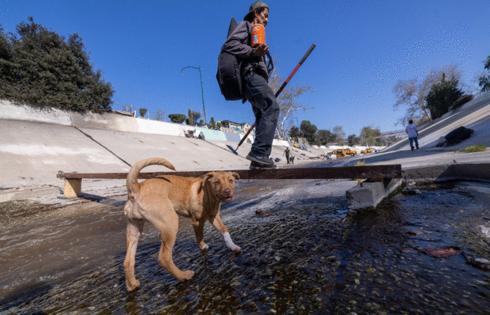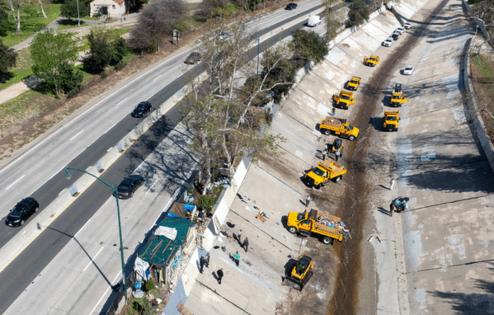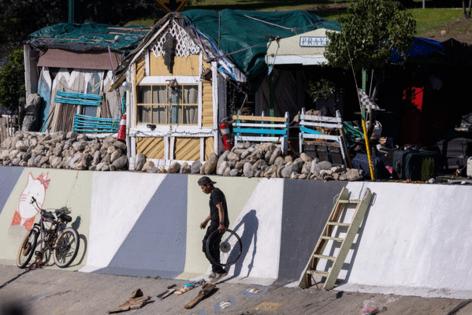The city of LA sent his home for the last 5 years down a flood channel along with many others
Published in News & Features
LOS ANGELES — A team of Los Angeles workers watched while waters from the Arroyo Seco flood channel carried away Alejandro Diaz's belongings as he broke down his home of the last five years Monday morning.
"It's an injustice," Diaz, 29, said in Spanish with tears streaking down his face. "The city doesn't care about anything other than destroying our lives even though we don't bother anyone. In all my time here none of us have bothered anyone."
After sunrise, the city went to work clearing an encampment along the parkway between the 110 Freeway and the flood channel that's existed there since the beginning of the pandemic. The shelters were dismantled by city workers and scraped off the flood channel floor with pitchforks, shovels and bulldozers while those who lived in them watched.
Diaz's home in the channel went viral last year, with news stories highlighting his skills in adding windows, bamboo fencing and a garden framed in bright yellow siding.
But last week, people living along the channel received paper notices warning them that their personal property could not be stored in a city park and would be removed during a scheduled cleaning, which the city typically does 72 hours after a warning is posted. The shelters sat on the opposite side of the flood channel from the Arroyo Seco Bike Path and a park.
The city targeted the shelters for cleanup because they are in a high-risk fire area, officials said. The cleanup was done by the city's Department of Recreation and Parks while Councilmember Eunisses Hernandez deployed outreach teams with LAHSA to contact the residents ahead of Monday's event.
Like many others living next to the flood channel, Diaz worked in construction, but could not find steady work. He occasionally found jobs as a day laborer in the parking lot of a local Home Depot, but said that he keeps to himself as much as possible.
He is among tens of thousands of people experiencing homelessness in Los Angeles County. The number of unhoused people in the county in 2024 dropped for the first time in five years but 2025 totals have not been released because the count was delayed due to the recent fires.
As cleanup crews operated Monday, Diaz kicked down his fence, smashed out the windows and rolled large boulders from his garden down into the flood channel. His girlfriend, Wendy, watched with their dog, Papi, a mixed-breed German Shepherd.
In a fit of frustration, the Guatemalan-born immigrant punched a dog house until his knuckles bled and cried when he thought about all the work he put into his slice of land that he had called home for the last five years.
"They don't know what they're doing to him," Wendy said.
Diaz asked that somebody take a picture of his home before and after the cleanup to show that he was here.
"I bet they won't clean any of it the right way," he said as he hugged his dog. Wendy and Papi stood by him later when he cried again.
Ahead of Monday's sweep, volunteer advocate Elizabeth Gustafson with the group Northeast Neighborhood Outreach sent a letter asking the city to reconsider, saying housing is limited and the people living along the flood channel work together to maintain their homes.
"Not only are sweeps disruptive to the unhoused people who have created community, mutual support, and neighborliness along the Arroyo against all odds, they are also an obscene waste of city resources, and they accomplish nothing," Gustafson wrote. "Angelenos are facing a staggering housing crisis, and it makes little sense to destroy homes and communities that have carved out a shred of stability amidst an untenable situation."
At another shelter, Los Angeles Police officers joined park rangers pushing their way into Cesar Augusto's home. Officers knocked on his door and then forced their way inside as his puppy, Salome, barked at them.
Officers told Augusto to clear out as cleaning crews began to dismantle the piles of items he gathered, including tools and cookware. Augusto, 44, arrived in Los Angeles roughly 20 years ago from Guatemala. He struggled to find steady work as a house painter after his employer died several years ago.
"There's no shame in what they're doing," he said about the city's cleaning operation. "God is always watching. He knows what happens."
Augusto's girlfriend sat nearby with their pup. They did not know where they would go next and watched as the treads of a bulldozer flatten their belongings.
A park ranger tried to shout questions to Augusto about his belongings over the roar of heavy machinery.
"Do you want any of it?" the ranger yelled. "I'm giving you plenty of time."
Lorena Amador, 51, was woken up to workers ripping down one of her shelter walls and telling her she had to leave, she said. Her goal for the day was to salvage her bedding and jackets and a park ranger was helping her out by holding some of her bags while she moved up and down the channel walls by rope.
As a bulldozer approached her shelter, she moved to the flood channel to wash her hair. The Arroyo Seco was an ideal alternative to living on the city streets, she said.
"We all know each other and we all got along," she said.
_____
©2025 Los Angeles Times. Visit latimes.com. Distributed by Tribune Content Agency, LLC.














Comments